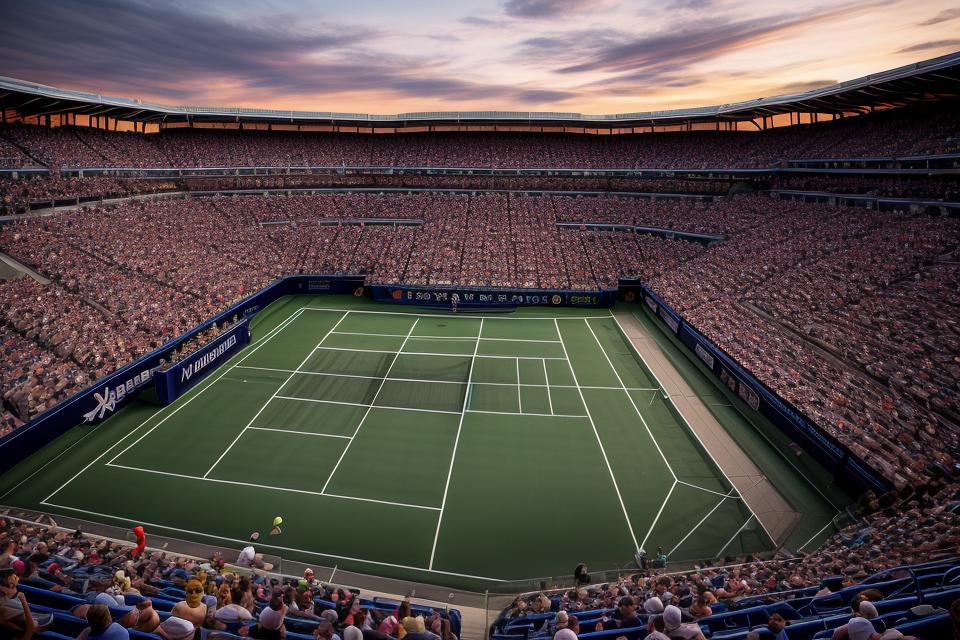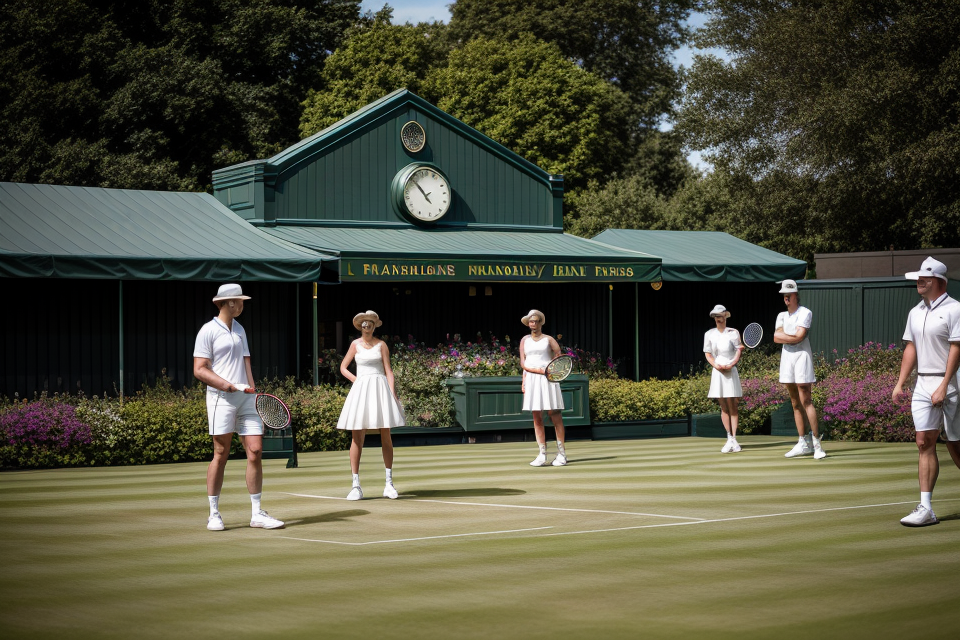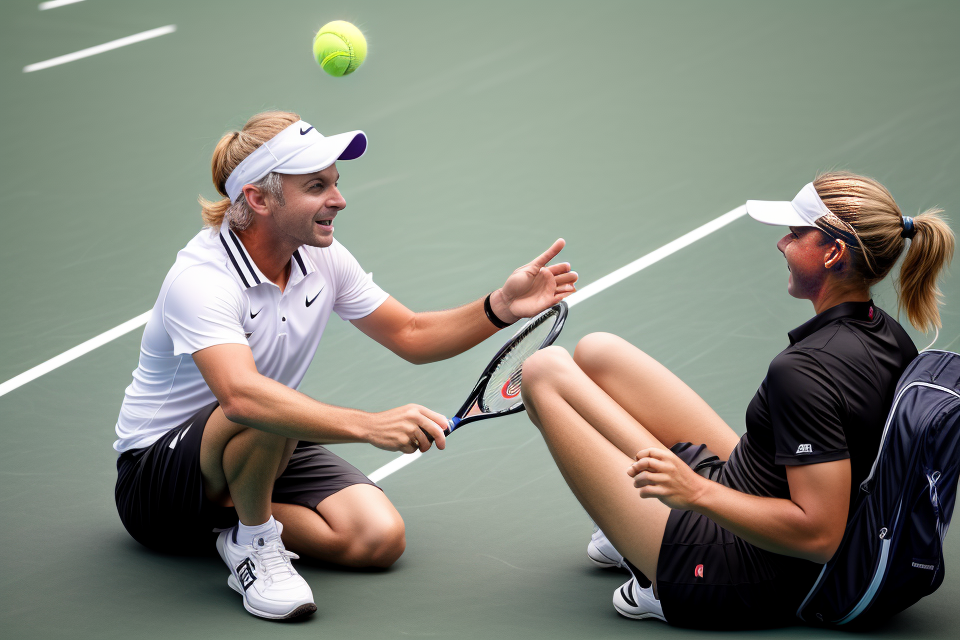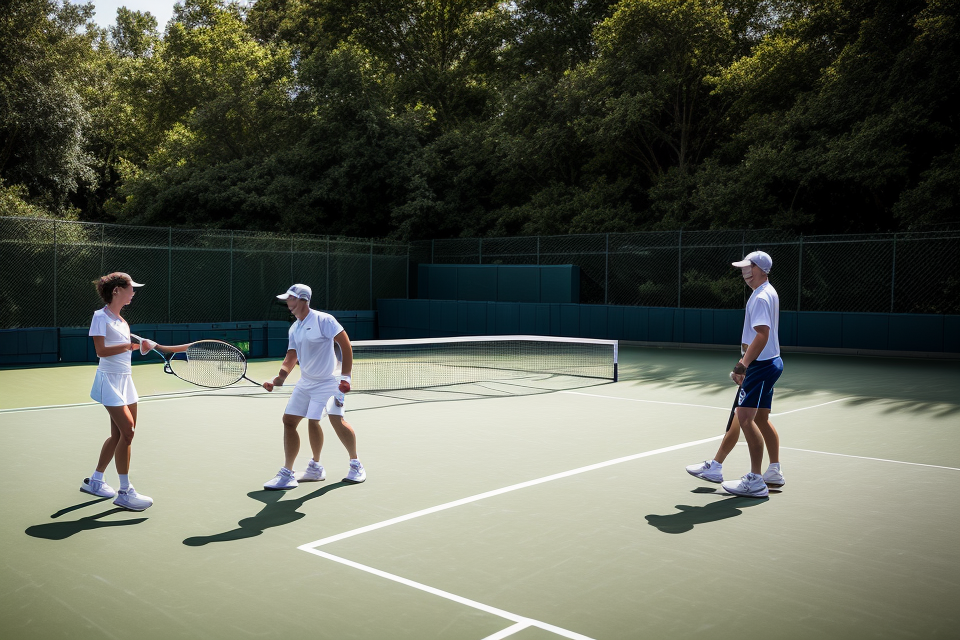As the U.S. Open tennis tournament approaches, players and coaches alike are preparing for the highly anticipated event. With some of the world’s top athletes competing for the coveted title, it’s no surprise that every aspect of the game is carefully scrutinized. One aspect that has been a topic of discussion in recent years is the role of coaches during the tournament. Specifically, many have wondered: can tennis coaches talk to players during the U.S. Open?
The answer is yes, but there are limitations. During the tournament, coaches are allowed to communicate with their players through a system of designated areas and communication methods. This means that coaches must remain in certain areas of the court and can only communicate with their players through hand signals or other non-verbal means. The purpose of these restrictions is to ensure that players are able to compete on a level playing field and that the outcome of the match is determined by their skill and performance, rather than outside influence.
However, despite these restrictions, coaches play a vital role in the success of their players. They provide guidance, support, and strategic advice that can make all the difference in a match. So, while they may not be able to speak to their players directly during the U.S. Open, coaches are still an integral part of the tournament and the success of their players.
Yes, tennis coaches can communicate with players during the U.S. Open. However, the mode of communication is limited to verbal instructions only, and coaches are not allowed to use electronic devices or any other means of communication. The rules and regulations of the U.S. Open allow for a maximum of two coaches per player, who can communicate with them during breaks in the game, and only if the player initiates the communication. The communication is subject to the umpire’s discretion, and they can intervene if they deem it necessary. Overall, the communication between coaches and players during the U.S. Open is regulated to ensure fair play and maintain the integrity of the game.
Rules and Regulations Governing Coach-Player Interactions
The Code of Conduct for Coaches
Communication Restrictions
During the U.S. Open, coaches are subject to strict communication restrictions to ensure fair play and prevent any outside influence on the players. Specifically, coaches are not allowed to provide any tactical advice or instruction to their players during matches. This includes signaling, gesturing, or making any verbal cues that could be interpreted as instructions.
Additionally, coaches are not permitted to use electronic devices, such as smartphones or tablets, to communicate with their players during matches. The use of such devices is strictly prohibited and can result in penalties for both the coach and the player.
Proper Attire and Behavior
Coaches are also required to adhere to specific dress codes and behavior guidelines during the U.S. Open. They must wear proper attire that is consistent with the professional and respectful nature of the event. This includes wearing a collared shirt, dress pants or shorts, and dress shoes or tennis shoes.
Furthermore, coaches are expected to maintain a professional demeanor at all times and to avoid any behavior that could be perceived as disruptive or disrespectful. This includes refraining from loud or boisterous behavior, demonstrating sportsmanship, and respecting the umpire’s decisions. Failure to adhere to these guidelines can result in penalties and sanctions for the coach and the player.
Player Responsibilities
Adhering to the Code of Conduct
During the U.S. Open, players are expected to adhere to a strict code of conduct that governs their behavior on and off the court. This code of conduct includes rules regarding communication with coaches and other support staff.
Seeking Assistance from the Umpire or Referee
If a player is unsure about the rules regarding communication with their coach, they can seek assistance from the umpire or referee. The umpire or referee is responsible for enforcing the rules of the game and can provide guidance to players on what is and is not allowed during matches.
Player Conduct
Players are expected to maintain proper conduct at all times during the tournament, including when communicating with their coaches. This means avoiding any behavior that could be considered unsportsmanlike or disrespectful towards opponents, officials, or spectators.
Penalties for Violations
Violations of the code of conduct can result in penalties for players, including fines and point deductions. In severe cases, players may be disqualified from the tournament.
Communication Devices
Players are not allowed to use communication devices, such as mobile phones or smartwatches, during matches. This includes using these devices to communicate with coaches or other support staff.
On-Court Coaching
On-court coaching is permitted during the U.S. Open, but there are strict rules regarding when and how it can be done. Players are allowed to receive coaching from their coaches between points, but not during points. Coaches must also adhere to certain guidelines, such as remaining within the designated coaching zone and not interfering with the flow of the match.
Overall, players are responsible for adhering to the rules and regulations governing coach-player interactions during the U.S. Open. This includes following the code of conduct, seeking assistance from the umpire or referee when necessary, and avoiding any behavior that could be considered unsportsmanlike or disrespectful.
Coaching Strategies and Tactics During Matches
On-Court Coaching
Permitted Coaching Activities
During the U.S. Open, coaches are allowed to provide players with specific instructions and guidance on the following aspects of the game:
- Tactics and strategy
- Technique and footwork
- Mental preparedness and focus
- Physical conditioning and injury prevention
Coaches are also permitted to offer encouragement and motivation to their players, as well as provide advice on how to manage the game situation, such as suggesting the right tactics for different scenarios.
Communication Limitations
Despite the extensive range of coaching activities allowed on court, there are limitations on the manner and frequency of communication between coaches and players during matches. These limitations are designed to ensure fairness and prevent excessive coaching interference:
- Coaches are not allowed to provide players with any physical assistance or interfere with the player’s movements during the match.
- Coaches must remain within the designated coaching area, typically located near the court’s sides or back, and must not obstruct the view of the umpire or line judges.
- Coaches are limited to a specific number of coaching visits per set, usually one or two, and must respect the timing of these visits as specified by the tournament rules.
- Coaches must adhere to the “radio silence” rule, which prohibits them from using electronic communication devices, such as smartphones or headsets, to convey coaching advice to players during matches.
- Coaches must refrain from making any comments or gestures that may be deemed as unsportsmanlike or disrespectful towards opponents, officials, or spectators.
Overall, on-court coaching during the U.S. Open is a vital component of the modern tennis coaching landscape, allowing players to receive expert guidance and support during matches. However, strict communication limitations are in place to maintain the integrity of the game and ensure fair competition between players.
Off-Court Coaching
During a match, coaches play a vital role in their player’s performance. However, there are specific rules that limit the coach’s ability to communicate with their player during the U.S. Open. This section will delve into the various strategies and tactics that coaches can employ when coaching their players off the court.
Feedback and Analysis
Off-court coaching provides an opportunity for coaches to provide feedback and analysis to their players between sets or during breaks. Coaches can review footage of the match to identify areas where their player can improve their performance, such as serving, returning, or volleying. They can also offer suggestions on how to adjust their strategy based on their opponent’s strengths and weaknesses.
Coaches can also use technology to analyze their player’s performance, such as using data tracking software to monitor their player’s movements and stats. This data can help the coach make informed decisions about their player’s tactics and strategy.
Nutrition and Hydration
In addition to providing feedback and analysis, coaches can also offer guidance on nutrition and hydration to their players. Tennis matches can be physically demanding, and it is essential for players to maintain their energy levels throughout the match.
Coaches can advise their players on what to eat and drink before, during, and after the match to ensure they are adequately fueled. They can also recommend hydration strategies to help their player stay hydrated during long matches.
Overall, off-court coaching during the U.S. Open is an essential aspect of a player’s performance. While there are limitations on the coach’s ability to communicate with their player during the match, they can still provide valuable feedback, analysis, and guidance on nutrition and hydration to help their player perform at their best.
The Impact of Coaching on Player Performance
Psychological Aspects
Building Confidence
During a tennis match, a player’s confidence can greatly impact their performance. A coach can help build a player’s confidence by providing positive feedback and encouragement. This can help the player feel more self-assured and able to handle the pressure of the game. Additionally, a coach can help a player develop a growth mindset, which is the belief that they can improve their skills through hard work and dedication. This can help the player overcome setbacks and stay focused on their goals.
Managing Stress and Anxiety
Tennis is a high-pressure sport, and players can experience stress and anxiety both on and off the court. A coach can help players manage these emotions by teaching them relaxation techniques, such as deep breathing and visualization. By helping players relax and stay focused, a coach can help them perform at their best even when under pressure. Additionally, a coach can help players develop a pre-match routine that helps them get in the right mindset for the game, which can help reduce anxiety and increase confidence.
Physical Aspects
Injury Prevention and Recovery
Injury prevention and recovery is a critical aspect of coaching in tennis. Coaches play a crucial role in ensuring that players maintain proper form and technique to avoid injuries. They also work with players to develop rehabilitation programs for injuries that have already occurred. This involves designing exercise regimens and therapy sessions to help players recover from injuries and return to full fitness as quickly as possible.
Fitness Training and Technique Improvement
Fitness training and technique improvement are also essential aspects of coaching in tennis. Coaches work with players to develop individualized fitness programs that are tailored to their specific needs and goals. This may include cardiovascular conditioning, strength training, and flexibility exercises. Coaches also provide guidance on technique improvement, such as developing a more effective serve or improving footwork on the court. By providing players with the tools they need to improve their physical abilities, coaches can help them perform at their best on the court.
The Future of Coaching in Tennis
Emerging Technologies and Analytics
Biometric Tracking and Performance Monitoring
Advanced Data Analysis and Machine Learning
In recent years, the integration of technology in sports has grown rapidly, and tennis is no exception. Tennis coaches are now exploring emerging technologies and analytics to improve their players’ performance and gain a competitive edge. In this section, we will delve into two of the most promising areas of technology in tennis coaching: biometric tracking and performance monitoring, and advanced data analysis and machine learning.
Biometric Tracking and Performance Monitoring
One of the most significant advancements in tennis coaching technology is biometric tracking and performance monitoring. With the help of wearable devices like smartwatches and sensors, coaches can now monitor their players’ vital signs, such as heart rate, pace, and distance covered, in real-time during matches. This data can provide valuable insights into a player’s physical exertion, allowing coaches to make informed decisions about tactics, training, and player management.
Some of the most popular biometric tracking devices used by tennis coaches include:
- Heart rate monitors: These devices measure a player’s heart rate during matches, providing insights into their physical exertion and fatigue levels. Coaches can use this data to optimize their players’ training and match schedules, ensuring they are working at the right intensity and avoiding overtraining.
- GPS trackers: GPS trackers monitor a player’s movement during matches, providing data on distance covered, average speed, and sprint distance. This information can help coaches identify patterns in a player’s movement and make recommendations for improving their efficiency and effectiveness on the court.
- Accelerometers: Accelerometers measure a player’s acceleration and deceleration rates, which can provide insights into their explosiveness and agility. Coaches can use this data to develop targeted training programs that focus on improving these aspects of their players’ performance.
Advanced Data Analysis and Machine Learning
Another promising area of technology in tennis coaching is advanced data analysis and machine learning. With the help of advanced analytics tools, coaches can now analyze vast amounts of data on player performance, opponents, and tournaments to gain a deeper understanding of the game and make data-driven decisions.
Some of the most popular advanced analytics tools used by tennis coaches include:
- Sports analytics software: These tools use advanced algorithms to analyze player performance data, such as ball spin, serve speed, and net coverage, to identify patterns and trends that can help coaches develop targeted training programs and strategies.
- Video analysis software: These tools use machine learning algorithms to analyze match footage, providing insights into an opponent’s playing style, strengths, and weaknesses. Coaches can use this data to develop strategies that exploit their opponents’ weaknesses and neutralize their strengths.
- Predictive analytics tools: These tools use machine learning algorithms to predict player performance and outcome probabilities based on historical data and current conditions. Coaches can use this data to make informed decisions about tactics, player selection, and match strategy.
In conclusion, emerging technologies and analytics are transforming the way tennis coaches communicate with players during the U.S. Open and other major tournaments. By leveraging biometric tracking and performance monitoring, advanced data analysis, and machine learning, coaches can gain valuable insights into their players’ performance, optimize their training and match strategies, and gain a competitive edge on the court.
Coaching Education and Certification
In the world of professional tennis, the role of a coach is becoming increasingly important. With the advancement of technology and the evolution of coaching techniques, the demand for highly qualified and certified coaches has risen. In response to this need, various organizations and institutions have developed coaching education and certification programs. These programs aim to enhance the coaching standards and provide specialized training to coaches, ensuring that they have the necessary skills and knowledge to work with elite-level players.
Enhancing Coaching Standards
Enhancing coaching standards is a critical aspect of the coaching education and certification process. The aim is to ensure that coaches are well-versed in the latest coaching techniques, methods, and technologies. These standards help coaches to develop their players’ physical, mental, and tactical abilities, ultimately leading to improved performance on the court. The International Tennis Federation (ITF) and the United States Tennis Association (USTA) are two organizations that set the coaching standards for the sport. They develop and implement coaching certification programs that cover a wide range of topics, including fitness, injury prevention, and mental toughness.
Specialized Coaching Courses and Programs
Specialized coaching courses and programs are designed to provide coaches with advanced training in specific areas of the game. For example, some coaches may specialize in developing the serving skills of their players, while others may focus on improving their players’ footwork and agility. These specialized courses and programs allow coaches to develop their expertise in specific areas, enabling them to provide more targeted and effective coaching to their players.
Some of the specialized coaching courses and programs available to coaches include:
- High-Performance Coaching: This course is designed for coaches who work with elite-level players. It covers advanced coaching techniques, such as periodization, match analysis, and mental toughness training.
- Tennis Fitness Coaching: This course focuses on the physical aspects of tennis and provides coaches with the knowledge and skills to develop comprehensive fitness programs for their players.
- Sports Psychology for Tennis: This course teaches coaches how to help their players develop the mental toughness needed to compete at the highest level. It covers topics such as goal setting, visualization, and stress management.
Overall, coaching education and certification programs play a crucial role in the future of coaching in tennis. They ensure that coaches have the necessary skills and knowledge to work with elite-level players and help them achieve their full potential.
Adapting to the Evolving Tennis Landscape
Mental Health and Well-being
The evolving tennis landscape has brought forth various challenges that coaches need to adapt to. One such challenge is the mental health and well-being of the players. Coaches need to be aware of the pressures and demands of the sport and how it can affect their players’ mental health.
One way coaches can adapt to this challenge is by providing support and resources for their players. This can include access to mental health professionals, stress management techniques, and mindfulness practices. By doing so, coaches can help their players manage the stress and pressure of competing at a high level, and ensure that they are able to perform at their best both on and off the court.
Diversity and Inclusion in Coaching
Another challenge that coaches need to adapt to is the lack of diversity and inclusion in coaching. Tennis has traditionally been a sport dominated by white players and coaches, and there is a need for more diversity and inclusion in the sport.
Coaches can adapt to this challenge by actively seeking out and recruiting players from diverse backgrounds. This can include reaching out to local community organizations, attending diverse tournaments, and building relationships with coaches and programs that serve diverse populations.
Additionally, coaches can also work to create a more inclusive and welcoming environment for all players. This can include promoting a culture of respect and understanding, and actively working to address any biases or prejudices that may exist within the sport. By doing so, coaches can help ensure that all players feel welcome and included in the sport, regardless of their background or identity.
Balancing Coaching Effectiveness and Integrity
In the modern era of tennis, coaches play a vital role in guiding and shaping the performance of players. The balance between coaching effectiveness and integrity is a crucial consideration for tennis coaches, particularly during high-profile events such as the U.S. Open. This subheading will delve into the challenges and opportunities associated with striking this balance.
Fostering Player Development
Tennis coaches are tasked with not only improving their players’ technical and tactical abilities but also nurturing their mental and emotional growth. This holistic approach to player development requires coaches to be attuned to the unique needs and preferences of each player, as well as the broader context in which they compete. Coaches must navigate the fine line between providing guidance and allowing players to find their own solutions to challenges on the court.
Upholding the Spirit of the Game
While coaching effectiveness is crucial, it must also be aligned with the spirit of the game. Tennis is a sport steeped in tradition and honor, and coaches are expected to uphold the values of fair play, respect, and integrity. Coaches must be mindful of the impact their coaching strategies and tactics have on the overall experience of the game for players, officials, and spectators.
One key aspect of upholding the spirit of the game is adhering to the rules and regulations set forth by the relevant governing bodies, such as the International Tennis Federation (ITF) and the United States Tennis Association (USTA). Coaches must ensure that their communication with players during matches is in line with these rules, which often restrict the types of advice that can be given and the methods by which it is conveyed.
In summary, tennis coaches must carefully balance the effectiveness of their coaching strategies with the integrity of the sport. By fostering player development and upholding the spirit of the game, coaches can help their players succeed on the court while maintaining the highest standards of sportsmanship and fair play.
FAQs
1. Are tennis coaches allowed to communicate with players during the U.S. Open?
Yes, tennis coaches are allowed to communicate with players during the U.S. Open. However, there are certain rules and regulations that coaches must follow. Coaches are not allowed to give players any advice or instructions during the match, but they can communicate with them between sets or during breaks. Coaches are also not allowed to enter the court during the match, except for certain medical emergencies.
2. How do tennis coaches communicate with players during the U.S. Open?
Tennis coaches can communicate with players through a variety of means during the U.S. Open. They can use hand signals, verbal cues, or written notes to provide feedback and instructions to their players. Coaches may also use electronic devices, such as smartphones or tablets, to communicate with players, but only in designated areas.
3. Can tennis coaches provide coaching during a match at the U.S. Open?
No, tennis coaches are not allowed to provide coaching during a match at the U.S. Open. The rules of the tournament prohibit coaches from giving any advice or instructions to their players while the match is in progress. This includes giving signals, making facial expressions, or using any other means of communication that could be interpreted as coaching.
4. What happens if a tennis coach violates the rules of communication at the U.S. Open?
If a tennis coach violates the rules of communication at the U.S. Open, they may be penalized by the umpire or tournament officials. The penalty may include a warning, point penalty, or disqualification from the tournament. It is important for coaches to understand and follow the rules of communication to avoid any penalties or disruptions to the match.
5. Are there any exceptions to the rules of communication for tennis coaches at the U.S. Open?
Yes, there are certain exceptions to the rules of communication for tennis coaches at the U.S. Open. For example, if a player is injured and needs medical attention, the coach may enter the court to provide assistance. Additionally, if a player requests permission from the umpire, their coach may be allowed to give them advice or instructions during a break in the match. However, these exceptions are rare and are subject to the discretion of the umpire or tournament officials.



